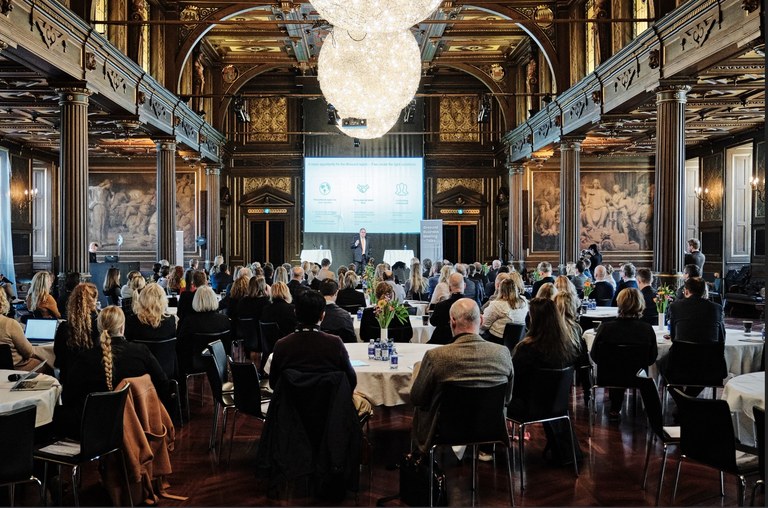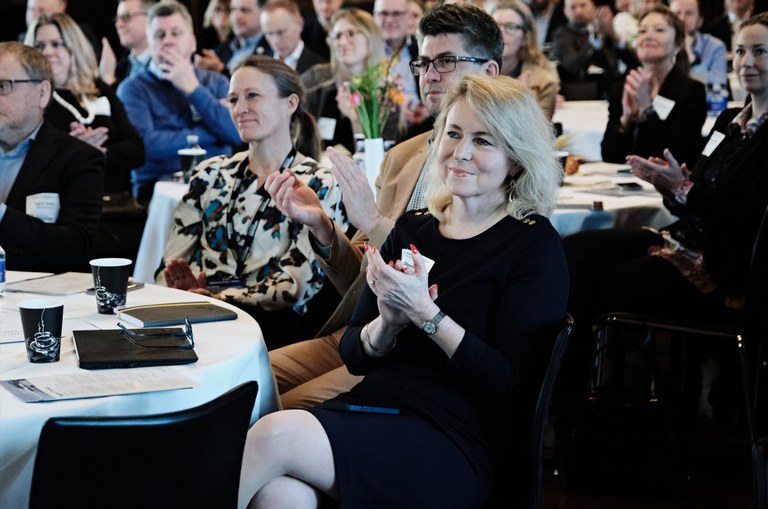Creating synergies for life science cooperation in the Öresund Region
Is a bridge enough to expand the common labour market in the Öresund region, or is more needed? The answer from Medicon Valley Alliances’ CEO is: We must also become better at identifying and using the factors that benefit both Denmark and Sweden and explore the potential of this.
“You achieve more by working together than on your own. Our system has proven to be strong and self-sustaining. When we cooperate, network and share knowledge, the whole becomes greater than the sum of its parts.”
That is what Anette Steenberg tells the Nordic Labour Journal on a sunny January Friday in Copenhagen. The Danish-born CEO of Medicon Valley Alliance has just stepped off the stage where she told the audience about the gains made by her non-profit life science organisation which has more than 320 members on both sides of the Öresund sound.
“Our organisation has members from private companies in Denmark and Sweden as well as specialist hospitals and universities that provide researchers. This triangle creates synergies which attract foreign companies,” says Anette Steenberg.

The Old Stock Exchange in Copenhagen is ancient
We are at The Old Stock Exchange which King Christian IV had built to increase Copenhagen’s trade. The building was ready in the mid-1620s and at the time had room for 40 market stalls across two floors.
The Öresundsregionen platform as a model
Just like The Old Stock Exchange, Medicon Valley Alliance was created to be a marketplace. It started in 1997 and was originally called Medicon Valley Academy. The current name came in 2007.
The aim was to create a platform allowing a cluster of Danish and Swedish institutions and companies that in some way or other were involved with life sciences to exchange ideas and services.
But the work goes beyond developing the platform in the Öresund region. Medicon Valley Alliance and Lund University are project leaders for HALRIC – a three-year Interreg project with members from Germany, Norway, Denmark and Sweden. It focuses on transforming innovation research based on the Öresund region’s unique infrastructure for life science, explains Anette Steenberg.
She underlines, however, that platform development should start with the involvement of only two states.
“That makes it easier than if all the Nordic countries were to be involved from the start. This would take too long. At Medicon Valley Alliance we first have to prove on a small scale that it works, and then take it to a larger level.”
The Öresund region – part of the Northern European labour market
Anette Steenberg and Medicon Valley Alliance are among several organisations meeting at The Old Stock Exchange’s main hall to discuss both the opportunities and the challenges in the Öresund region. Also participating are representatives from business, the Nordic Council of Ministers, media, and the Danish and Swedish Parliaments,

The situation for commuters was discussed during the Copenhagen meeting.
The Øresund Bridge is the host for the meeting that will be focusing on the upcoming expansion of the labour market region. The Fehmarnbelt tunnel between Denmark and Germany will be opening in six years. 18 kilometres long, it will be the world's longest immersed tunnel. It is being constructed with support from the EU infrastructure fund in order to strengthen the transport network and increase railway freight in the EU.
The link will remove the bottleneck between the Nordics and the continent, and thus contribute to the creation of a larger, common labour market in Northern Europe.
“The infrastructure means a lot for life science production activities. We already cooperate with Oslo and Hamburg, and with the Fehmarnbelt tunnel we get better access to facilities like ESS and MAX IV in Lund and DESY and European XFEL in Germany,” says Anette Steenberg.
The train journey from Rødbyhavn on the Danish island of Lolland to Puttgarden on the Northern German island of Fehmarns will take seven minutes. By car, the trip will take 10 minutes.
The challenges
The journey between Denmark and Germany is not the only bottleneck that needs removing to fully exploit the Öresund Region labour market.
Better conditions are needed for those who directly represent this common labour market – the train and car commuters who cross the Öresund Bridge or those who take the ferry between Helsingborg and Helsingør for jobs on the other side. The fight for improved conditions has been going on for years.
That is why the Copenhagen meeting focused on the commuters’ situation. What is needed to attract more people who are willing to make the journey between Sweden and Denmark or vice versa?
Some of the requests presented during the meeting, include:
- The removal of border controls between Denmark and Sweden – “the police should stop criminals, not commuters” as one of the speakers put it. (Since the meeting, The Chamber of Commerce and Industry of Southern Sweden has requested a judicial review from the Supreme Administrative Court of Sweden to establish whether the internal border controls are legal*).
- Revising the Öresund tax agreement between Denmark and Sweden, to make it relevant for today’s labour market by for instance accepting working from home – pandemic or not – without changing the country you tax to.
- Allowing people to accept a second job – or board assignment – in their home country while also doing so “on the other side”.
Big business
Making these and other changes would mean an opportunity to make more money. A lot of money according to the Danish Chamber of Commerce, which now owns The Old Stock Exchange.
Their analysis concludes that some 11,600 Swedish commuters to Denmark contributed some 8.8 billion Danish kroner (€1.18bn) to the Danish economy in 2021. This, explains the Chamber of Commerce’s marketing director, means that strengthening the common Danish and Swedish labour market and increasing the number of commuters across the Öresund Bridge is “big business”.
The Öresund Region represents big business for the life science sector, which has announced major investments. This year they have announced major investments.
“We are taking about new investments worth 50 billion Danish kroner (€6.7bn) from existing life science activities in the Danish part of Medicon Valley. These investments are primarily for manufacturing development,” says Anette Steenberg.
Someone has to take the lead
She has previously spent 20 years as a diplomat around the world, working with the internationalisation of Danish companies – getting them out into the world while attracting foreign companies to Denmark.
“The key words for my career are and always have been the internationalisation of business. I build bridges between countries,” she says.
“But I am also Danish and therefore I am impatient. I cannot sit still and wait for things to happen, I want to act. You have to take the lead if you want others to follow,” says Anette Steenberg, ending our interview at the former Copenhagen marketplace.
*In a press release dated 9 February 2023, the Chamber of Commerce and Industry of Southern Sweden writes:
“The Chamber of Commerce’s request is that the court reverses the government’s decision and determines that this for now will not be applicable. The background is a ruling from the EU Court from April 2022 which further clarifies the legal position around the controls.”
The press release refers to the Germany Bertelsmann Stiftung which “shows that the border controls cost Sweden 50 billion euro in lower GDP if they will remain in place until 2025”. They will be detrimental to commuting and a functioning labour market. It recently emerged that Danish police do not believe border controls work and that increased cooperation is better."
- Anette Steenberg
-
is the CEO of Medicon Valley Alliance. She has had an extensive career in the Ministry of Foreign Affairs of Denmark and has recently worked with the combination of life science, investment promotion and regional development in Greater Copenhagen as investment director at Copenhagen Capacity.
 Follow us on Facebook
Follow us on Facebook
